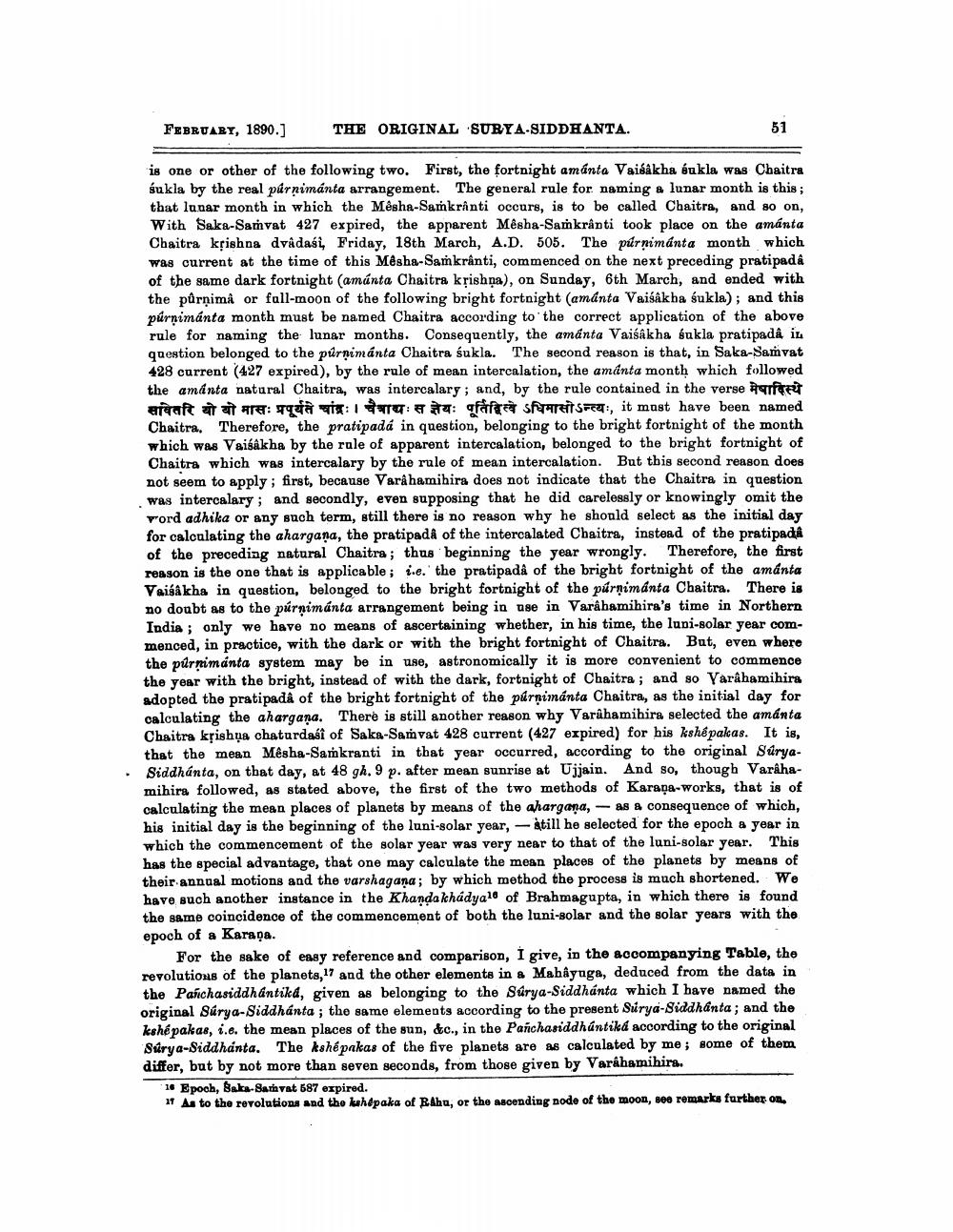________________
FEBRUABY, 1890.)
THE ORIGINAL SURYA-SIDDHANTA.
is one or other of the following two. First, the fortnight amánta Vaisakha sukla was Chaitra sukla by the real pürnimánta arrangement. The general rule for naming a lunar month is this; that lunar month in which the Mêsha-Samkranti occurs, is to be called Chaitra, and so on, With Saka-Samvat 427 expired, the apparent Mêsha-Samkranti took place on the amánta Chaitra kļishna dvadasi, Friday, 18th March, A.D. 505. The purnimanta month which was current at the time of this Mêsha-Samkranti, commenced on the next preceding pratipada of the same dark fortnight (amánta Chaitra krishna), on Sunday, 6th March, and ended with the pûrņimå or full-moon of the following bright fortnight (amanta Vaisakha sukla); and this púrnimánta month must be named Chaitra according to the correct application of the above rule for naming the lunar months. Consequently, the amanta Vaisakha sukla pratipadê in question belonged to the purnimánta Chaitra sukla. The second reason is that, in Saka-Samvat 428 current (427 expired), by the rule of mean intercalation, the amanta month which followed the amanta natural Chaitra, was intercalary; and, by the rule contained in the verse Afri ateraft Are: Toata l
: affect STARTSFEU, it must have been named Chaitra. Therefore, the pratipadá in question, belonging to the bright fortnight of the month which was Vaisakha by the rule of apparent intercalation, belonged to the bright fortnight of Chaitra which was intercalary by the rule of mean intercalation. But this second reason does not seem to apply; first, because Varahamihira does not indicate that the Chaitra in question was intercalary; and secondly, even supposing that he did carelessly or knowingly omit the Ford adhika or any such term, still there is no reason why he should select as the initial day for calculating the ahargana, the pratipadå of the intercalated Chaitra, instead of the pratipada of the preceding natural Chaitra ; thus beginning the year wrongly. Therefore, the first reason is the one that is applicable; sie. the pratipadå of the bright fortnight of the amanta Vaisakha in question, belonged to the bright fortnight of the purnimanta Chaitra. There is no doubt as to the púrnimánta arrangement being in use in Varahamihira's time in Northern India; only we have no means of ascertaining whether, in his time, the luni-solar year commenced, in practice, with the dark or with the bright fortnight of Chaitra. But, even where the púrrimanta system may be in use, astronomically it is more convenient to commence the year with the bright, instead of with the dark, fortnight of Chaitra ; and so Varahamihira adopted the pratipadâ of the bright fortnight of the purnimánta Chaitra, as the initial day for calculating the ahargana. There is still another reason why Varahamihira selected the amánta Chaitra kļishṇa chaturdast of Saka-Samvat 428 current (427 expired) for his kshé pakas. It is, that the mean Mêsha-Samkranti in that year occurred, according to the original SúryaSiddhánta, on that day, at 48 gh. 9 p. after mean sunrise at Ujjain. And so, though Varâhamihira followed, as stated above, the first of the two methods of Karaņa-works, that is of calculating the mean places of planets by means of the ahargana, - as a consequence of which, his initial day is the beginning of the luni-solar year, - till he selected for the epoch a year in which the commencement of the solar year was very near to that of the luni-solar year. This has the special advantage, that one may calculate the mean places of the planets by means of their annual motions and the varshagana; by which method the process is much shortened. We have such another instance in the Khanda khádyale of Brahmagupta, in which there is found the same coincidence of the commencement of both the luni-solar and the solar years with the epoch of a Karana.
For the sake of easy reference and comparison, I give, in the accompanying Table, the revolutions of the planets, 17 and the other elements in a Mahâynga, deduced from the data in the Parichasiddhantikd, given as belonging to the Súrya-Siddhanta which I have named the original Súrya-Siddhanta; the same elements according to the present Súrya-Siddhanta ; and the kshé pakas, i.e. the mean places of the sun, &c., in the Panchasiddhántiká according to the original Súrya-Siddhanta. The kshé pakas of the five planets are as calculated by me; some of them differ, but by not more than seven seconds, from those given by Varahamihira.
16 Epoch, Saka-Samvat 587 expired. 11 As to the revolutions and tho khapaka of BAhu, or the ascending node of the moon, 800 remarks further on




